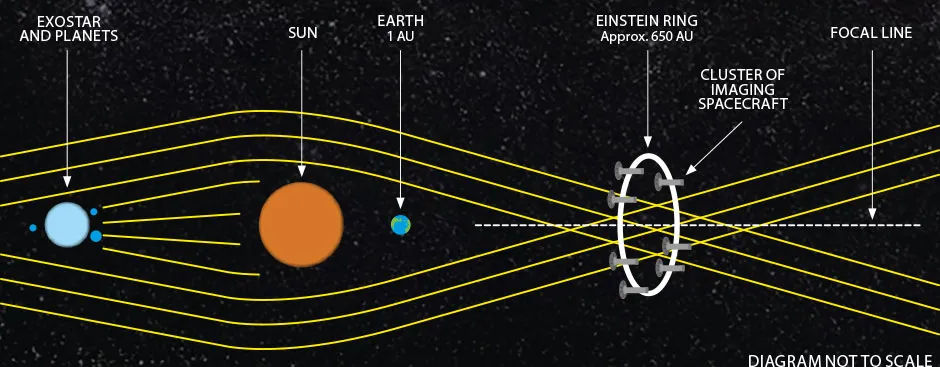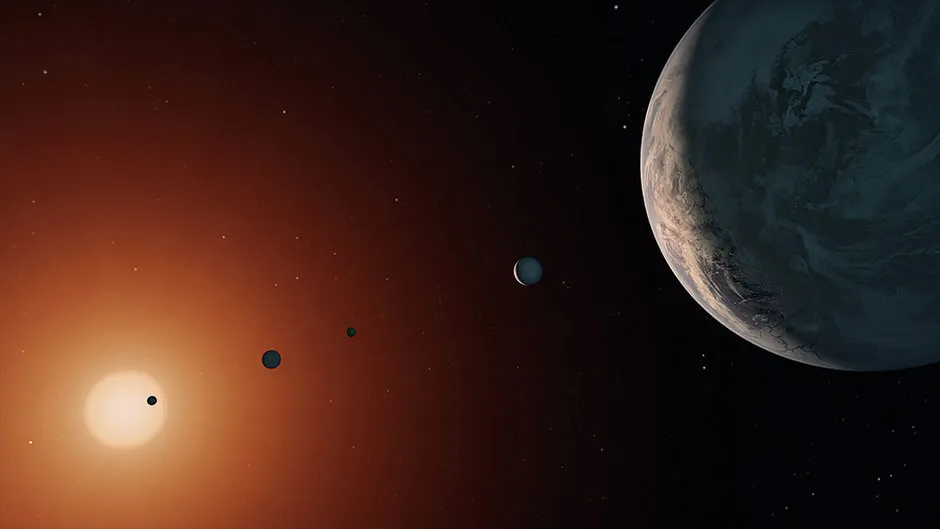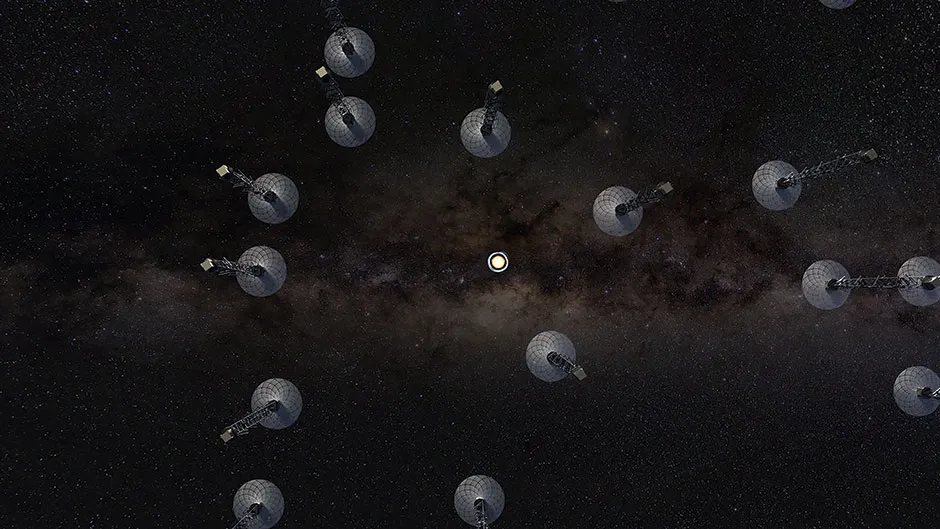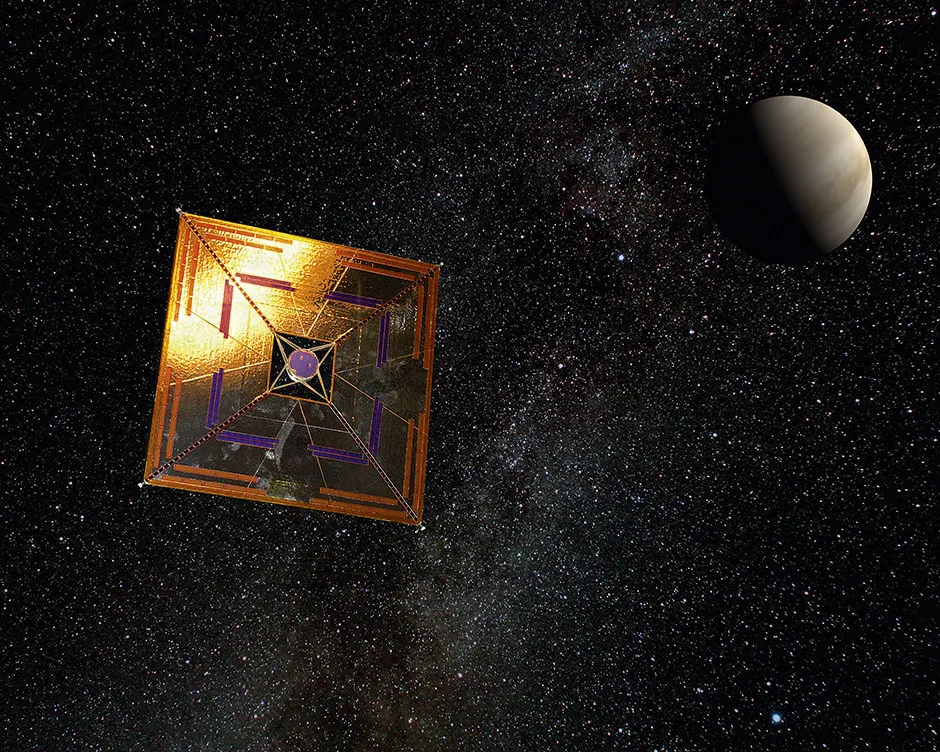A spacecraft hurtles out of the Solar System travelling faster than any rocket, probe or instrument we’ve launched into space before. It’s on a daring mission to answer some of the most fundamental questions about the Universe once and for all. “We’ve all been asking them since we were six years old,” says Slava Turyshev from NASA’s Jet Propulsion Laboratory. “Are there other planets? Can we see them? Is there life?”
Astronomers have revolutionised our understanding of our place in the Universe over the last quarter of a century. In 1995 they found their first alien planet orbiting a Sun-like star. It whetted their appetites to such a degree that we’ve been hunting them down ever since. At the last count there are over 4,000 of these exoplanets in our databases. Some of them even appear to have similar traits to Earth – close in both size and temperature. That quickens the pulse and often makes headlines because if life can thrive on our planet, it could be doing the same on an exoplanetary cousin.
But for Turyshev there’s a frustrating catch. “We infer these planets – we don’t see them,” he says. Potentially Earth-like exoplanets often sit hundreds of light-years away. That’s too far for us to see them directly. Instead we have to tease out their presence, usually by seeing the light from their star dim ever so slightly as the planet passes in front, or seeing the star wobble due to the planet’s gravitational pull.
Even scanning starlight passing through the planet’s atmosphere for signs of oxygen and water is prone to producing false positives. That makes it very hard for astronomers to produce definitive proof that these planets are indeed the stage for life’s great theatre. Who’s to say they aren’t just lifeless mirages in the cosmic desert? It’s no wonder we’re aching for a closer look.
Read more about exoplanets:
- Can life exist around a black hole?
- What does it mean if an exoplanet is 'habitable'?
- Hubble’s greatest discoveries: Exoplanet atmospheres
The challenge of imaging an Earth-like exoplanet – even as just a single pixel in a photograph – is immense. “If I want to see another Earth from a distance of 100 light-years, I need a telescope with a diameter of 90km,” Turyshev says. Its mirror would cover an area larger than London, Paris, New York and Tokyo combined. The biggest telescopes on Earth right now have mirrors around 10m across.
Even the new Extremely Large Telescope, currently under construction in Chile, will ‘only’ have a 39m mirror when its finished in 2025. “We can’t see the planets behind the headlines with existing telescopes or even those planned for the near future,” Turyshev says. If we want a more detailed image – the kind that would tell us something useful about the planet – the diameter would need to increase even further.
All is not lost, however. Turyshev is the brains behind an audacious idea to exploit an astronomical loophole – something he describes as “a gift from nature”. He’s working on a brand-new way to image an Earth-like exoplanet using the biggest thing for light-years around: the Sun.
Massive objects like the Sun distort the fabric of space around them. The Earth, for example, is caught in the gravity well the Sun makes, which is why we’re stuck in orbit around it. Any light approaching the Solar System from elsewhere is forced to follow this local curvature of space. The light ends up being bent around the Sun in an effect called gravitational lensing.
Like a giant magnifying glass, the Sun amplifies the light from distant exoplanets by up to 100 billion times. To see an image of the exoplanet we just have to get a spacecraft to the region where the Sun brings its light to a focus.

It’s the Universe’s own enormous telescope – one that astronomers could only ever dream of building. The Sun does so much of the heavy lifting that the spacecraft we send to catch the light would only need a one-metre mirror – less than half the diameter of the mirror in the Hubble Space Telescope.
The potential for this kind of technique is huge. Rather than seeing the whole planet as a single pixel, Turyshev’s calculations show that by using the Sun we could achieve a resolution of 20km per pixel. “We’d be able to see continents, oceans and weather patterns,” he says. Forests and deserts would show up, too.
A big city like London would take up more than one pixel. So we might be able to notice that regions change brightness as night falls and the lights of an alien city begin to shine. “With a solar gravitational lens that all becomes possible,” Turyshev says.
We would be limited to only exploring one alien solar system per mission, though. “We won’t be able to repoint towards a new star,” Turyshev says. The precise alignment required means that the planet you want to image has to be in a direct line behind the Sun. Usually we head towards a planet we want to explore, but for this we’d need to travel away from it in exactly the opposite direction.
Probing another star system with the same spacecraft would require moving to another region of space, something beyond the scope of Turyshev’s initial proposal. We would, however, be able to explore multiple planets orbiting the same star.
The TRAPPIST-1 system could be a promising first candidate. We already know that there are seven roughly Earth-sized planets there and we could image them one by one as part of the same mission. Each planetary portrait would take around eight months to put together.

With such a big prospective pay-off, you may be wondering why this hasn’t been tried already. The reason is that it’s an enormous engineering challenge. The solar gravitational lens brings the light of a typical exoplanet to an observable focus around 650 astronomical units (AU) away, where one AU is the distance between the Sun and Earth.
For context, Neptune, the furthest confirmed planet in our Solar System, orbits the Sun at an average distance of 30AU. The Voyager 1 probe, the spacecraft that’s travelled furthest from Earth to date, has only reached a distance of 150AU since its launch in 1977. NASA’s New Horizons probe holds the record for the fastest spacecraft to depart from Earth, but was still only travelling at a rate of just over 3AU per year en-route to Pluto. At similar speeds it would take almost 200 years to trek out to the focus of the lens.
“We need to be able to get there in a human lifetime,” Turyshev says. Not least because it’s only fair that the people who build the spacecraft get to see the fruits of their labour. Everyone’s inner six-year-old is also impatient – we want answers to those enduring childhood questions as soon as possible.
To pull this off we’re going to have to move away from the kind of propulsion we usually use for interplanetary missions. Instead a spacecraft equipped with a solar sail could reach speeds of25AU per year, getting us there in around a quarter of a century.

Solar sails operate in a similar way to the sails on a boat, catching the gusts of solar wind blown out by the Sun or riding on the jet stream of light – particles of sunlight hitting the sails propel the craft just like particles of air do on Earth.
“Missions like Japan’s IKAROS and [The Planetary Society’s] LightSail have already successfully demonstrated solar sails in space,” Turyshev says. “We already have the technology we need to do this.” His proposed spacecraft would be equipped with 16 sails, each with an area of 1,000m2. NASA is keen enough on the idea to back his work with funding through its Innovative Advanced Concepts programme.
Prof Lewis Dartnell, an astrobiologist at the University of Westminster, is excited by the prospect. “If we could build such a futuristic technology it would be an absolute boon for astrobiology,” he says. “This would give astronomers an enormous capability for assessing how habitable the exoplanet might be.”
Dr Nicholas Rattenbury, from the University of Auckland in New Zealand, agrees. “To discover features on an exoworld that we could associate with a biosphere would be sensational,” he says. Although his enthusiasm is tempered with a note of caution. “This would be an extremely challenging mission – it represents one of the most ambitious goals I’ve seen in exoplanet discovery.”

So what’s the next step on the road to making such a complex dream a reality? Turyshev is planning to fly a technology demonstration mission – a scaled-down version to show that the solar sail propulsion system could work in principle.
“It would reach speeds of 7AU per year – twice the current record,” he says. If that goes well, he hopes we could launch the spacecraft for real by 2035, meaning it would arrive at the focus of the solar gravitational lens in around 2060. “It’s an aggressive timeline, but we already have all the ingredients in place – we just have to put them together,” he says.
We may have to wait a while, but patience is part of the process. “The hunt for another Earth is a generations-long search,” says Prof Sara Seager, an exoplanet hunter at the Massachusetts Institute of Technology.
But we still need to be thinking about tomorrow’s telescopes today. “We 100 per cent want to invest in brand-new technologies – [they’re] needed if we want follow up on any intriguing discoveries we make in this generation,” she says. All the more reason to continue to catalogue intriguing systems such as TRAPPIST-1 so that we’re ready to go when new missions come online later this century.
Coincidentally, Turyshev’s proposed timeline would see the first image returned not long after the centenary of the launch of Sputnik 1, the first satellite to reach Earth orbit. If it takes us a mere 100 years to go from dipping our toe in the celestial waters to photographing sprawling metropolises on alien planets, could there be other civilisations using their own solar gravitational lens to peer at Earth? “Absolutely,” says Turyshev. “I’ve no doubt that somewhere else in the Galaxy there are people who know how we live here.”
Thanks to his work, it may only be a matter of time until we join a club of astronomers whose membership extends beyond the Solar System and we can finally get answers to those questions that our inner children won’t stop asking.
- This article first appeared inissue 362ofBBC Science Focus Magazine–find out how to subscribe here
Read more about the future of exploration:
- James Webb Space Telescope: Inside the high-stakes testing of Hubble’s £7.2bn successor
- Deep-sea mountains: Earth’s unexplored ecosystems that are teeming with life
- How scientists are using cosmic radiation to peek inside the pyramids
- How humanity will return to the Moon: The future of lunar exploration
- Frozen lakes and underground waterfalls: Inside the Dark Star deep cave system
- Psyche: The metal mini-world that could change everything we know about the Solar System
